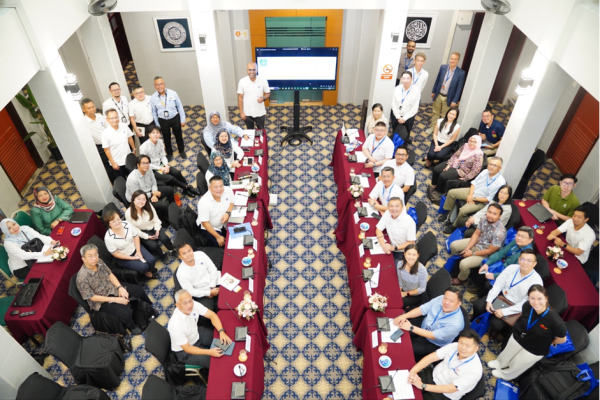Date: 20 – 21 August 2024
Location: Selangor & Negeri Sembilan, Malaysia
Read our press statement on the event here.
Read relevant news here and here.
View our Programme booklet here.
Preamble
There currently exists a window of opportunity for Malaysia and other countries in Asia to take advantage of geopolitical headwinds between China and the US as well as the global push towards supply chain security.
With semiconductors slated as the “new oil”, Malaysia as a key player in the global supply chain for semiconductors is in a unique position to capture much of this opportunity. Further, there are many other supporting and related industries that Malaysia can also develop or strengthen as well as diversify into, such as green economy industries which will be one of the key drivers of global growth as countries across the world rush to transition towards sustainability and greener societies.
However, the competition is tough, with goals such as to move up the value chain, improve downstreaming and provide quality jobs and incomes, these shared aspirations also mean competing interests, especially among ASEAN member states.
It is with this backdrop that Research for Social Advancement (REFSA), with the support of Invest Selangor and Selangor Information Technology and Digital Economy Corporation (SIDEC) organised a semiconductor study tour in Selangor / Negeri Sembilan (NS). The tour is an extension of a similar tour conducted earlier in May focusing on Penang / Kulim. The aim of these tours is to further deliberate Malaysia’s opportunities and strategies to strengthen its position as a key player in the global semiconductor industry.
Summary
The tour delved into understanding industry players in the Central region, their positioning and how they relate within Malaysia’s semiconductor ecosystem. As the tour commenced, it became obvious that one of Malaysia’s strengths is a well established and flourishing local ecosystem through an existing chip corridor stretching from the Northern region to the South region. While the Northern cluster has often dominated discussions, the Selangor – NS cluster plays a crucial role within the supply chain, from Outsourced Semiconductor Assembly and Test (OSAT) services to various front-end solutions for enablers of the chip making process to the production of the chips.

Some overall observations:
- Geopolitical climate. Malaysia continues to benefit from the escalating tensions between global superpowers by leveraging on its non-aligned stance. This approach reinforces Malaysia’s position as a secure, resilient, and reliable link in the supply chain amid a world of uncertainty. With countries seeking to diversify their sources and de-risk from potential escalation of hot or proxy wars, Malaysia has experienced an influx of foreign direct investments (FDIs) to develop its chip-making process and supply chain in the country. Manufacturers consistently emphasised that Malaysia’s clear direction articulated via the New Industrial Master Plan (NIMP) 2030 and National Semiconductor Strategy (NSS) provided the necessary vision and roadmap for companies to consider establishing its base in Malaysia. Global companies based in Malaysia also expressed growing inclination to continue expansion and investments in Malaysia.


- Why Selangor and Negeri Sembilan? While companies conceded that the initial decision to establish operations in Selangor – NS may not be driven by a deliberate strategy, the choice to remain is a calculated one, attributing it to reduced competition in terms of talent attraction and retention, cost-competitiveness, and access to infrastructure and resources. In response to an increasingly competitive environment for resources in the Northern region, Selangor – NS provides a great alternative to build operations and presence, while logistically, still being heavily linked to the vibrant supply chain in the Northern region. On that note, companies welcomed more efforts from the government and relevant agencies to connect the entire semiconductor corridor through deeper integration of services, logistics and complementary cooperation to avoid isolated and competing entities in various regions of the nation.
- Gaps in the local supply chain. On localisation of procurement (of equipment and materials), companies lamented the availability and quality of local suppliers. Specifically, there are either no suitable suppliers of key components required to produce equipment within Malaysia, or the existing local suppliers do not meet the stringent standards required by global players. This underscores the urgency of nurturing new local suppliers to fill the gaps and of grooming existing local suppliers to align with international quality benchmark and ESG standards. Despite that, the delegation witnessed success stories of local companies. For example, one evolved from a mere distributor of semiconductor equipment to developing its own machine that automates visual testing processes. In line with the nation’s aspiration to move up the value chain, many companies are demonstrating the potential to scale-up through developing their own IPs and know-hows to provide solutions for the entire supply chain.

- Infrastructure improvement required. Companies highlighted the importance of fundamental infrastructure to stay competitive in this industry. Consistent electricity supply ensures factories do not lose out on damaged products due to power outages. While water is required to cool systems, effective water treatment processes are vital to ensure operations are in a clean environment and reduce damaged products on semiconductor fabrication due to particles, microorganisms or organic compounds.
- Talent deficit. The Malaysian talent pool, though commended by industry players for its world-class skills, faces a persistent supply shortage, particularly in more niche and specialised areas such as R&D and front-end processes. As demands continue to evolve in the global market, most companies we visited have concrete expansion plans, which would inevitably lead to an increased demand for skilled talent. A significant observation was the existing skills gap among school-leavers. Educational institutions are falling short in meeting the ambitions of the industry, suggesting a disconnect between academic training and practical industry needs. In response, companies took a proactive approach through active collaborations with universities to enhance the quality and readiness of graduates for the industry. Such collaborations should be enhanced and multiplied as part of the push to create a highly skilled, qualified workforce.
This visit exposed the strengths, weaknesses, opportunities, and risks of the semiconductor industry through the lens of the Selangor – NS cluster. Moving forward, strategic trilateral coordination between the public, private and academic sectors will be key to facilitate the development of the semiconductor ecosystem on the foundation of our existing advantages to realise the visions of the National Semiconductor Strategy.
Read our press statement on the event here.
Read relevant news here and here.
View our Programme booklet here.

